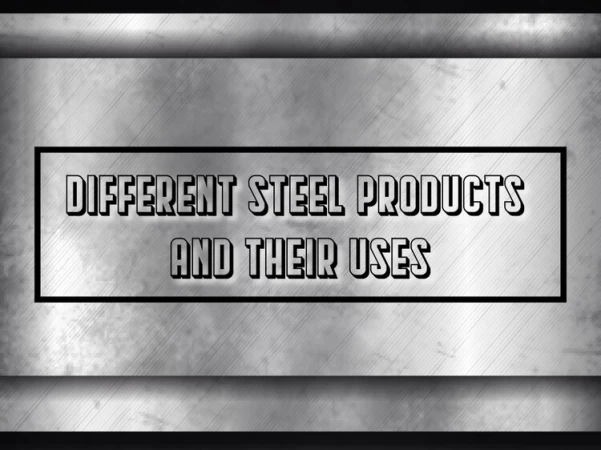
There’s no other material which exhibits a high-level of versatility, than steel. Its many properties make it a sought after alloy when it comes to various kinds of production and manufacturing techniques. Through manipulations on its grain structuring, many industries have made it possible to create steel productsthat offer advantages to building structures, roofing, HVAC installations, and the like.
As an alloy, steel has a high ductility, machinability, and strength rating — among others. It can also be subject to many kinds of processes to make it suitable for environmental conditions and be able to withstand wear and tear. As such, the resulting products have been made to provide stability, strength, and function in everyday uses. Continue reading to learn more.
Steel pipes
Steel pipes are typically used in the transmission and transfer of different types of fluids. These products can be spotted in almost any kind of installation — whether it be something smaller in scale, such as residential, or in civil engineering projects.
Knowing the functions of piping systems, it’s important that the product used be able to resist high temperature and pressure levels that are exerted on the material. Therefore, steel is one of the best choices for piping because of its anti-corrosive and strength properties — whether it be in HVAC installations or petrochemical plants. One can be assured that no form of minor damages such as burst piping or leakages will occur with steel piping work. Aside from this, the cost of cleaning and maintaining steel pipes will be lowered, also reducing the need for unnecessary and time-consuming inspections.
Checkered steel plates
Checkered steel plates are also a testament to the versatility of steel. It’s used in a range of structural, industrial, and decorative purposes, making this steel product one work of ingenuity.
For larger-scale installations, checkered plates are used in industrial plants and facilities as part of the flooring system. The patterned design makes it suitable for areas that experience a high level of foot traffic on a daily basis, due to the added traction. Employees who work in these types of environments would be protected from minor accidents like slippages and other kinds of avoidable workplace hazards.
This steel product is also widely used among residential spaces, as part of corner guards, or door kicking mechanisms. It’s useful in protecting the lower parts of swing doors made of wood, as well as protecting corners.
Corrugated steel sheets
One of the most popular applications for corrugated steel sheets can be found in roofing systems. Though many buildings make use of shingles, concrete, or rubber slate as roofing material, steel sheets add an unparalleled level of protection to a building’s structure.
Corrugated steel sheets are designed in such a way to prevent leaks from occurring inside a building. For example, during rainy conditions, the water that hits the surface of these sheets will travel in a downward, sloping motion — effectively carrying the water away from the inside of the house.
Corrugated roofing also protects buildings from damages that may occur as a result of environmental factors, such as falling objects, and the like. The high-strength steel roof won’t be prone to damages that may reduce its functionality and distort its appearance.
Castellated beam
The greatest advantage of using castellated steel beams over regular beams, is that the former is more lightweight compared to the latter. These castellated beams have distinct openings that may come in a variety of shapes, whether it be circular, or rectangular.
Castellated beams are produced through cutting an original beam on the sectioned area. The resulting material is then welded together with the original beam to produce the castellation.
Due to its design, castellated beams cost less to manufacture, precisely because less of the steel material is required. It’s also more durable compared to original beams because of the way its two parts are combined with each other. Having said this, they’re mainly used in adding support to ceiling and the structure found in inner walls.
Steel wires
These steel products can be found in virtually everyone you look at. They can be spotted in fencing, suspension bridges, conductor cables, automotive, and more. Furthermore, they can also be shaped into almost any desired form because of the low-density sizing as well as its high malleability.
Steel manufacturing plants do not necessarily produce only one type of steel wire — instead, they may arrive in varying dimensions and thickness. For example, suspension bridges may require thicker materials to support the structure, while on the other hand, instruments such as guitars, or violins may use thinner steel cores.
Pipe fittings
Steel is also used in the production of pipe fittings which are utilized alongside steel pipes in order to redirect, or combine the flow of different fluids. By allowing steel to be subject to various metal cutting and extrusion techniques, it’s been made possible to produce compact, yet low-weight fittings.
Many kinds of fittings exist, namely: elbow fittings, couplings, cross-type, plugs, flanges, and reducers, just to name a few. Some of these fittings have been designed in such a way, to enable the combination of different piping sizes without having to make drastic modifications on the pipe itself. Likewise, the durability of the fittings ensures that only little-to-no maintenance is conducted on the piping system.
Key Takeaway
Steel productscan come in the form of castellated beams, pipes, pipe fittings, sheets, wires, and more. You can already gather just how malleable this kind of alloy is, compared to other alloys.
Because steel can be used in different types of applications, it’s important to consider how the alloy’s grain structure plays a role in either enhancing or subsequently reducing its properties to adapt to a specific application.